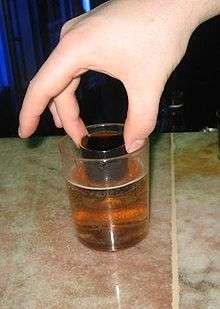Jägerbomb
 | |
| A shot of Jägermeister dropped into a beer, creating a Jägerbomb. | |
| Standard drinkware | A pub glass and a shot glass. |
|---|---|
| Originally Jägermeister and beer | |
The Jägerbomb /ˈjeɪɡərˌbɒm/ is a bomb shot mixed drink that was originally mixed by dropping a shot of Jägermeister into a glass of Red Bull or other energy drinks.[1] In German-speaking countries, it is called a "Turbojäger"[2] or a "Fliegender Hirsch"/"Flying Hirsch" (Flying Stag)—where "Fliegender" is derived from the slogan "Red Bull verleiht Flügel" (Red Bull gives you wings) and "Stag" originates in the Jägermeister logo. A long drink mixed with Jägermeister and Red Bull is called "JägerBull". In Finland, it is called an "Akkuhappo" (Battery Acid)[3] while in Greece it is called "Υποβρύχιο" (Submarine)(note that the most common definition of "Υποβρύχιο" in Greece is whiskey/vodka with beer, lately the term "Jägerbomb" is more widely understood and accepted).[4]
Commercial preparation
A Jägerbomb is usually sold with a can of Red Bull or an equivalent energy drink, poured into a pint glass and separately accompanied by Jägermeister in a shot glass. The glass of Jägermeister is then dropped into the Red Bull.
Jäger-train
A Jäger-train is a theatrical method for preparing the drinks when multiple Jägerbombs have been ordered. Glasses of Red Bull are lined up, and an empty glass is placed at one end. Shot glasses of Jägermeister are then balanced on the lips of the glasses. The first shot glass (which is on the empty-glass end) is pushed over; it falls into the Red Bull in the next glass and—if the glasses are correctly positioned—it will simultaneously knock over the next shot glass. A domino effect will be created, causing each shot glass to fall into a glass of Red Bull.[5][6] In order for the trick to work, the shot glasses need to be tall enough (or drink glasses narrow enough) so that one shot glass knocks over the next shot glass in the line. The train can also be arranged into a Jäger-ring that completes itself.
-

A Jäger-train with fifty bombs
-

The preparation of multiple Jägerbombs (a Jäger-train)
Effects on the drinker
The effects of a Jägerbomb are similar to those of other drinks that contain both caffeine and alcohol. These effects are held to be different from those of strictly alcoholic drinks. This is attributed to the fact that caffeine has a stimulating effect on the central nervous system, whereas alcohol has a depressing effect. Consequently, some of the effects of alcohol intoxication are masked. However, caffeine does not affect the reduced motor coordination that is typically seen in intoxicated persons. There have been reports of drinkers being hospitalized after excessive consumption of Jagerbombs due to the effect of excessive caffeine.[7]
A Brazilian study conducted in 2006 found that combining an energy drink and alcohol "appears to show us that the use of energy drinks might predispose people to abuse alcohol when its depressant effects—or at least the perception of such effects—are masked by them".[8] Professor Roseli Boergnen de Lacerda, who conducted the study, also warned of another possible effect: "a higher risk of car accidents because [people who drank energy drinks with alcohol] felt less intoxicated than they were".[9]
See also
- Caffeinated alcohol drinks ban
- F-Bomb—Fireball Cinnamon Whisky and Red Bull[10]
- Irish Car Bomb
- Sake bomb
- Skittle Bomb
- Rev-Bomb
References
- ↑ "Jägerbomb drink recipe". Drinknation. Retrieved 26 August 2009.
- ↑ "Cocktailrezept Turbojäger" [Cocktail recipe Turbojäger]. Cocktail Scout (in German). Retrieved 16 August 2008.
- ↑ "Akkuhappo". Drinkkiklubi (in Finnish).
- ↑ Article in greek listing the different versions of the Jagerbomb: "The seabattles of alcohol are fought with Jagerbombs"
- ↑ Video of a Jäger-train
- ↑ Video of a Jäger-train
- ↑ http://www.mirror.co.uk/news/uk-news/jayde-dinsdale-downed-10-jagerbombs-3213293
- ↑ "Combining Alcohol and Popular Energy Drink Reduces the 'Perception' of Impairment". Science Daily. Rockville. 30 March 2006.
- ↑ "Energy drinks and alcohol don't mix". NEOVOX Australia. 14 May 2007. Archived from the original on 8 May 2012.
- ↑ Hoare, Peter (9 January 2014). "5 Awesome Drinks You Can Make With Fireball Cinnamon Whisky". Food & drinks. MTV. Retrieved 17 June 2014.